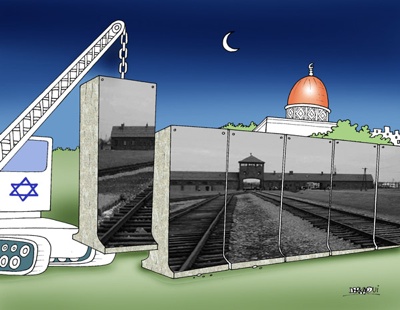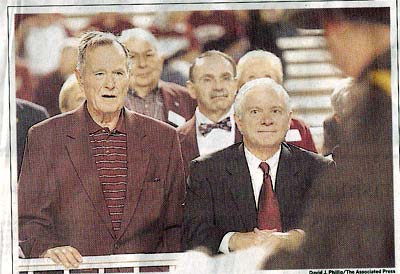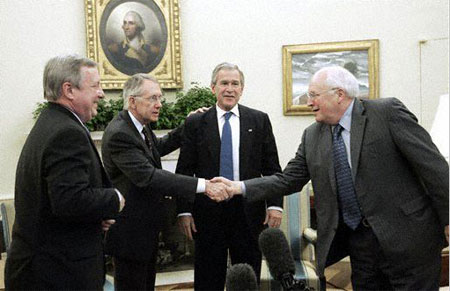Notes
Your Turn: The Iran Holocaust Cartoon
Responding to last year’s firestorm over the depiction of Mohammed in the paper, Jyllands-Posten, the Iranian newspaper, Hamshahri, has announced its winner of “the International Holocaust Cartoon Competition.” Sidestepping the fact that the original Muhammed cartoons came out of Denmark, the theme of the Iranian contest was anti-Israeli, based specifically on the negation of the Holocaust.
I’ve been following the contest at Daryl Cagle’s blog.
The winner, a Moroccan cartoonist named Derkaoui, is one of the artists whose work is shown on Cagle’s well-known Cartoon Index. Given the amount of discussion the Danish images stimulated here at The BAG (The Cartoon That Could End The World – link), I thought it worthwhile to discuss Derkaoui’s image; the extent to which his visual analogy makes sense; and whether the cartoon is consistent with his explanation of it.
On first pass, the cartoon poses Israel, or Israeli held territory, as a death camp for Palestinians (and equates Israel’s treatment of the Palestinians with the Nazi’s treatment of the Jews). The rendering, however, can also been seen as more ambiguous than that, making other interpretations possible.
One reason for the ambiguity is because of the artist’s curious choice to include photography.
The level of realism (black-and-white, not withstanding) makes the wall function like a window or a mirror (more than an embedded symbol as if the death camp was drawn on the wall, like a billboard). As a window, the implication is that the Jews, on their side of the wall (and in their relationship with the Palestinians) are either recreating or reliving their own experience of the death camps. As a mirror, the concentration camp reflects back on the Palestinian side and the Palestinian consciousness, as if the Palestinians have either internalized the Jewish Holocaust experience, or are doing something to bring this perception upon themselves. And, working both ways at once, it casts the same pox on both houses.
The geographic situation is also a bit ambiguous. It’s not exactly clear, for example, why the crane and the mosque are on the same side. (Is the setting Jerusalem? Does Israel control both sides? Was it just a layout consideration?) Also, because it’s an Iranian contest, could the wall actually be separating Israel from Iran?
And, one last thing. Don’t those wall sections look a lot like the U.N. headquarters?
I invite you to also consider the image in terms of the author’s comments. (Because Cagle’s blog doesn’t permalink, I am reproducing his email exchange with Derkaoui below.)
Dear Derkaoui,
I read today that you won the Holocaust denial cartoon contest in Iran. I wondered if you could send me an image of the winning cartoon along with your comments about your cartoon and the contest.
I’m sure you know that this contest was organized for the purpose of answering the perceived insult against Muslims from the Danish Muhammad cartoons with what would be considered a reciprocal insult in the form of cartoons that would be offensive to Jews (although the editors and cartoonists involved with the Danish cartoons were not Jewish.) This would be an opportunity for you to address criticism of the contest and your participation in the contest.
I hope to hear from you!
And the reply:
As you know, I won first place in the Iran cartoon contest which had the theme: “Why do the Palestinian people pay the price of butchery for the Holocaust?”
I took part in this contest to express my support for the Palestinian people and I did a drawing showing the Israeli wall isolating the Palestinian territories being lifted by an Israeli war machine; I added a photograph to the wall showing the Auschwitz concentration camp.
I want to express my total heartfelt sympathy with the millions of Jewish victims of the Holocaust who suffered the greatest crime against humanity under the Nazis. Nobody can deny that more than six million people were massacred during the second world war by the devil Hitler and his Nazi henchmen. But the question for me and for so many others is why the Palestinian people have suffered from so much pain, and massacres, and why they continue to suffer in the current situation.
As a citizen of Morocco it is my deepest conviction that Jews are my brothers; Jews have lived with us in peace and tolerance as fellow citizens in Morocco for 2000 years. I remember that in World War II, Morocco did not cooperate with the Vichy government of France when the King of Morocco stood up to the German demands and refused to send thousands of Moroccan Jews to the German concentration camps. I am proud of Morocco for taking this noble stand. I am proud of Morocco which has been and will be tomorrow, a place of tolerance between Jews and Muslims, who will live here together like brothers.
Reading these comments and studying the image, I wonder how much the cartoon actually satisfies the contest’s intention, which is to deny the Holocaust. Does the cartoon convey that the Holocaust is solely a cultural myth or mental representation? Or, does it actually give credence to the fact of the Holocaust, forcing the viewer to have to account for it in some manner, in the specific context of the people on either side of this barrier?
Because many sites deal with the politics of these images, but only one delves specifically into the images themselves, I respectfully ask that the discussion focus on, and not lose sight of the cartoon.
———————
Update 5:28 CET: I wanted to address some confusion about the contest, the contest rules, and the extent to which the theme involved Holocaust denial.
As I understand it, the contest was co-sponsored by Iran’s Cartoon House and the Hamshahri newspaper, both of which are funded by the city government in Tehran. The original contest question asked, “What is the limit of Western freedom of expression?” In initially describing the contest, however, Masoud Shojai-Tabatabai, the head of Cartoon House, was quoted as follows: “We wanted to challenge European taboos. Why should questioning the Holocaust be a taboo?”
On one hand, the contest addresses the Holocaust in general, and the limits of Western expression on the subject. At the same time, USA Today quotes Iranian Culture Minister Mohammad Hossein Saffar-Harandi, in his speech announcing the winners, as saying: “The Holocaust is a myth and this issue has finally made waves thanks to the action of President Ahmadinejad in daring to express himself on the subject and break the Holocaust taboo.”
I would say I am incorrect above in stating the theme of the contest as the denial of the Holocaust. (I am also suprised that Cagle, who runs the most visible and widely accessed cartoon site, would also frame the contest is such unqualified terms.) On the other hand, when you read the statements of the organizers, and consider their close connections to the Iranian government, which frequently makes statements such as those I’ve quoted, its hard not to think that the organizers were playing it both ways.
(image: Derkaoui. 2006. via cagle.msnbc.com/news/blog/)



Reactions
Comments Powered by Disqus